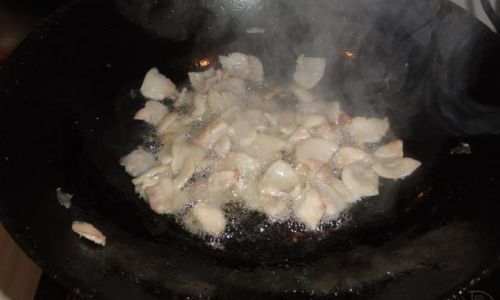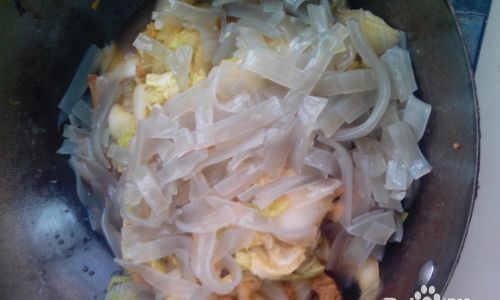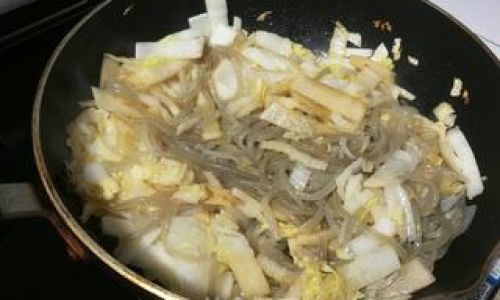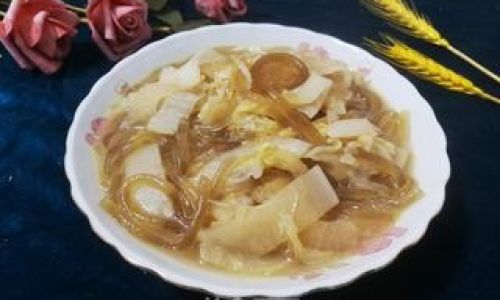Introduction
In the realm of comfort food, few dishes rival the warmth and simplicity of a hearty stew. Among the most beloved recipes in Northern Chinese cuisine is Cabbage, Potato, and Glass Noodle Stew—a dish that marries earthy flavors, tender vegetables, and chewy noodles in a savory broth. This humble yet satisfying meal has been a staple in households for generations, prized for its affordability, ease of preparation, and ability to nourish both body and soul. Whether served on a chilly winter evening or as a filling lunch, this stew embodies the essence of home-cooked goodness. In this guide, we will explore the art of crafting this dish from scratch, delving into ingredient selection, knife skills, seasoning techniques, and the alchemy of slow-cooked flavors.

Ingredients: Assembling the Building Blocks
Before igniting the stove, gathering the right ingredients is paramount. This recipe balances fresh produce, aromatic spices, and pantry staples to create a symphony of textures and tastes. Here’s what you’ll need:
-
Vegetables:
- 1 medium-sized cabbage (preferably Napa or green cabbage for its mild sweetness).
- 3 medium potatoes (Russet or Yukon Gold varieties work best for their starchy texture).
- 1 large carrot (for a touch of natural sweetness).
- 1 small onion (yellow or white, finely diced).
- 3 garlic cloves (minced).
- 1-inch ginger root (grated or finely chopped).
-
Proteins and Noodles:
- 100g dried glass noodles (also known as cellophane noodles or mung bean noodles).
- 150g ground pork or beef (optional, for added richness; vegetarians can omit or substitute with mushrooms).
-
Aromatics and Seasonings:
- 3 tablespoons vegetable oil (or any neutral cooking oil).
- 2 tablespoons soy sauce (preferably light soy for saltiness).
- 1 tablespoon dark soy sauce (for color and depth).
- 1 teaspoon sugar (to balance acidity).
- 1 teaspoon white pepper (or black pepper, if preferred).
- 4 cups chicken or vegetable broth (low-sodium recommended).
- 2 tablespoons Shaoxing wine (or dry sherry for non-alcoholic substitution).
- 1 star anise (optional, for aromatic complexity).
- Salt to taste.
-
Garnishes:

- 2 green onions (thinly sliced).
- 1 red chili pepper (deseeded and minced, for heat).
- 1 tablespoon sesame oil (for finishing).
Step-by-Step Instructions: Crafting the Stew
Preparing the Vegetables
The foundation of this stew lies in properly prepping the vegetables. Begin by rinsing the cabbage under cold water, then pat it dry. Remove any wilted outer leaves and slice the cabbage into 1-inch strips, discarding the tough core. For the potatoes, peel them and cut into 1.5-inch cubes—ensure uniformity to guarantee even cooking. Peel and julienne the carrot into thin matchsticks. Mince the garlic and ginger finely, as they will infuse the broth with aromatic undertones.
Soaking the Glass Noodles
Glass noodles require pre-soaking to soften before cooking. Place the dried noodles in a large heatproof bowl and cover them with boiling water. Let them sit for 8–10 minutes, or until pliable but not mushy. Drain and rinse under cold water to prevent sticking. Set aside.
Searing the Aromatics and Protein
Heat the vegetable oil in a heavy-bottomed pot or Dutch oven over medium heat. Add the diced onion and sauté until translucent (3–4 minutes). Stir in the minced garlic and ginger, cooking for an additional minute until fragrant. If using meat, add the ground pork or beef at this stage, breaking it into small crumbles with a wooden spoon. Cook until browned (5–7 minutes), then drain excess fat if desired.
Building Flavor with Spices and Liquids
Introduce the star anise (if using) to the pot, followed by the Shaoxing wine. Deglaze the pan by scraping up any browned bits from the bottom—this caramelized fond is key to depth of flavor. Add the soy sauces, sugar, and white pepper, stirring to combine. Pour in the broth, increase the heat to high, and bring the mixture to a rolling boil.

Simmering the Stew
Once boiling, reduce the heat to low and add the potatoes and carrots. Simmer gently for 15 minutes, or until the potatoes are nearly tender. Nestle the cabbage strips into the pot, submerging them in the broth. Cover and cook for another 10–12 minutes until the cabbage wilts and the vegetables are fork-tender.
Incorporating the Glass Noodles
Gently fold the soaked glass noodles into the stew, ensuring they are fully submerged. Avoid vigorous stirring to prevent breaking the noodles. Cook for an additional 5 minutes, or until the noodles are translucent and have absorbed the broth’s flavors. Taste and adjust seasoning with salt or pepper as needed.
Finishing Touches
Remove the pot from heat and discard the star anise. Drizzle the sesame oil over the stew, then garnish with sliced green onions and minced chili. The sesame oil adds a nutty aroma, while the fresh herbs provide a vibrant contrast.
Tips for Success: Elevating Your Stew Game
- Texture Control: Overcooking glass noodles can result in a mushy stew. To avoid this, soak them just until pliable and add them toward the end of cooking.
- Broth Customization: For a richer broth, substitute water with homemade bone broth or enhance store-bought broth with a Parmesan rind or tomato paste.
- Spice Level: Adjust the chili quantity to suit your palate. For smokiness, add a pinch of smoked paprika or a dash of chili oil.
- Vegetarian Adaptation: Omit meat and use mushroom-based broth. Sauté sliced shiitake mushrooms with the aromatics for umami depth.
- Leftovers: This stew tastes even better the next day as the flavors meld. Store in an airtight container for up to 3 days.
Variations and Customizations
The beauty of this recipe lies in its adaptability. Here are creative twists to experiment with:

- Seafood Infusion: Add shrimp or cubed firm tofu during the final 5 minutes of cooking.
- Fermented Flavors: Stir in a tablespoon of doubanjiang (spicy bean paste) or kimchi for a tangy kick.
- Herbaceous Notes: Tear fresh cilantro or basil leaves into the stew before serving.
- Crispy Topping: For texture contrast, fry thinly sliced garlic or shallots until golden and sprinkle over each bowl.
Serving Suggestions: Pairing Perfection
This stew shines when paired with simple accompaniments that highlight its rustic charm. Serve it alongside:
- Steamed Jasmine Rice: To soak up every last drop of broth.
- Crusty Bread: Ideal for dipping into the flavorful liquid.
- Pickled Vegetables: A tangy side like daikon radish pickles cuts through the richness.
- Iced Tea or Light Beer: To cleanse the palate between bites.
Cultural Significance: The Stew’s Humble Origins
In Northern China, where winters are harsh and resources limited, this stew emerged as a frugal yet nourishing solution. Cabbage and potatoes, being storage crops, formed the backbone of many meals, while glass noodles provided a satisfying carbohydrate boost. The dish’s popularity endures not only for its taste but also for the memories it evokes—of family gatherings around steaming bowls, of generations sharing recipes across kitchen tables.
Conclusion: The Joy of Slow-Cooked Simplicity
In an era of haste, the act of simmering a stew feels almost revolutionary. This Cabbage, Potato, and Glass Noodle Stew invites you to slow down, to savor the rhythm of chopping, stirring, and waiting. Each spoonful tells a story—of earth’s bounty, of culinary tradition, and of the quiet joy found in nourishing others. Whether you’re a seasoned cook or a novice in the kitchen, this recipe offers a gateway to the heart of comfort food. So gather your ingredients, warm your pot, and let the magic of the stew unfold.
Final Note:
This dish is a canvas for creativity. Feel free to adjust ingredient ratios, experiment with spices, or add personal touches. After all, the best recipes are those that carry the imprint of your own kitchen adventures. Enjoy!






0 comments